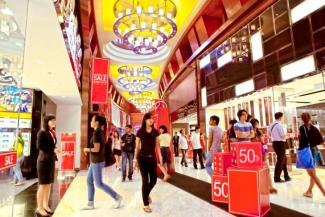
[Singapore, 17 June 2015 (Wednesday)] – The Institute of Service Excellence at the Singapore Management University (ISES) (卓越服务研究院) today released the 2015 first quarter (Q1) Customer Satisfaction Index of Singapore (CSISG) results for the Retail and Info-communications sectors.
In face-to-face interviews with 9,000 resident and tourist respondents between January and March 2015, the latest findings revealed customer satisfaction for the Retail sector rose by 0.4-points (+0.5%) year-on-year to 70.0-points (on a 0 to 100 scale). The Info-communications sector also registered a higher score, rising 0.6-points (+0.9%) year-on-year to 67.4-points.
Of the eight sub-sectors measured within the Retail sector, two recorded significant improvements: the Motor Vehicles sub-sector increased by 2.2-points (+3.1%) to 72.8-points, while the Petrol Service Stations sub-sector increased by 1.4-points (+2.1%) to 70.7-points. The other six Retail sub-sectors, namely Clocks & Watches (69.2-points), Departmental Stores (68.6-points), Fashion Apparels (69.3-points), Furniture Stores (66.7-points), Jewellery Stores (69.3-points), and Supermarkets (70.6-points), recorded changes that were not considered statistically significant.
Notwithstanding the minor movements in the Retail CSISG scores, analysis in this latest quarter revealed that the importance of customers’ perceptions of value in driving satisfaction has been on the decline in the last two years. While price promotions can help drive customers into stores, it has become increasingly insufficient in driving satisfaction.
Segmenting the Retail customers further into local and tourist respondents showed differing magnitudes in how various service touchpoints impact perceptions of quality and satisfaction. For example, in Departmental Stores, while “courteous staff” was the most impactful attribute of perceived quality for both local and tourist customers, “store layout” was considerably more important to tourist customers than it was for the locals.
Assistant Professor of Marketing (Practice) Marcus Lee (李德发), Academic Director (学术总监) of ISES said, “The changing visitor numbers to Singapore may be beyond the control of most businesses here, but once the customer is in the door, stores must be able to match the experience with expectations and managers must be cognisant of its customers’ profiles and their potentially different perceptions of what constitutes a great experience.”
Within the Info-communications sector, the Mobile Telecoms sub-sector saw its score increase by 1.1-points (+1.7%) to 68.4-points, while the Broadband (64.9-points), Pay TV (65.1-points), and Wireless@SG (59.6-points) sub-sector scores all inched lower by 0.4-points (-0.6%), 1.5-points (-2.2%), and 1.9-points (-3.1%), respectively.
A key observation in the Info-communications sector was customers’ perceptions of dispute resolution. Typically, a well-handled complaint results in satisfaction levels similar to customers who have no reason to complain. For example, in 2014, Info-communication customers with well-handled complaints were only 3.2% less satisfied than those with no reason to complain. However, in 2015, Info-communications customers with well-handled complaints had, on average, a satisfaction score 22.5% lower than those who had no reason to complain.
Commented Dr Lee, “The larger discrepancy could point towards fundamental issues customers may be having with the product or service, issues that customer service may not be able to resolve, nor should it be expected to. Rather, companies should use the opportunity to review its value proposition.
“In the longer term, the solution is to shape customer expectations using branding and communications to position the experience such that the customers better know what to expect. In essence, businesses are ensuring they are attracting the group of customers that will appreciate their service proposition,” he remarked.
Please refer to Annex A for a background on the CSISG and the 2015 study, and Annex B for the detailed scores.
For media queries, please contact:
Mr Tim Zhuang
Senior Manager, Marketing and Research
Institute of Service Excellence at SMU (ISES)
DID: (65) 6808 5258
Mobile: (65) 9748 9389
Email: timzhuang [at] smu.edu.sg (timzhuang[at]smu[dot]edu[dot]sg)
Mr Teo Chang Ching
Assistant Director, Corporate Communications
Office of Corporate Communications and Marketing
DID: (65) 6828 0451
Mobile: (65) 9431 8353
Email: ccteo [at] smu.edu.sg (ccteo[at]smu[dot]edu[dot]sg)